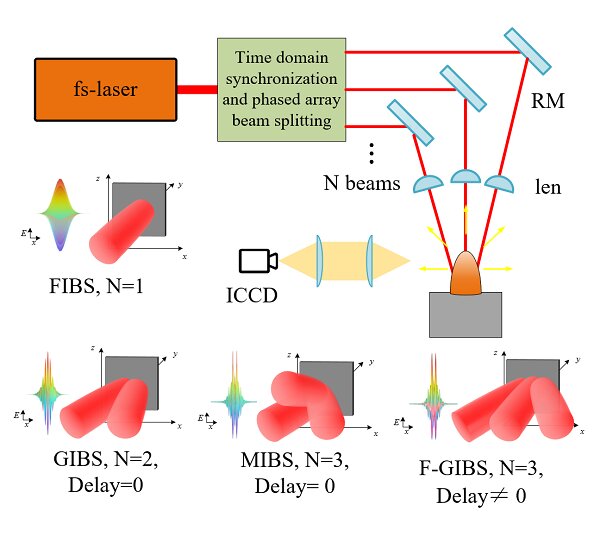

The research team of the State Key Laboratory of Precision Spectroscopy at East China Normal University has made significant progress in the field of ultra-fast laser-induced breakdown spectroscopy technology.
The team has recently proposed groundbreaking plasma-grating induced breakdown spectroscopy (GIBS) and multidimensional plasma grating induced breakdown spectroscopy (MIBS) techniques, ascertaining that these novel methods exhibit heightened levels of sensitivity to the traditionally employed LIBS and filament-induced breakdown spectroscopy (FIBS).
Substrate effects and plasma shielding interference typically plague traditional nanosecond laser-induced breakdown spectroscopy. On the other hand, filament-induced breakdown spectroscopy is restricted by peak power constraints, rendering sensitivity difficult to improve. To surmount these obstacles, the research team first developed the technique of plasma gratings-induced breakdown spectroscopy.
Utilizing two non-collinearly coupled filament pulses, this method forms a plasma grating to surmount the peak power restrictions and enhance the electronic density of the excitation, enabling a quantum leap in sensitivity and overcoming interference from the plasma shielding effect.
To further enhance the excitation effect, the research team went on to propose the technique of multidimensional plasma grating-induced breakdown spectroscopy. This method utilizes three non-collinear and non-coplanar femtosecond pulses that interact with the sample to generate plasma grating. The team successfully observed the diffraction effect of the plasma grating, achieving a progression from one-dimension to two-dimension.
The periodic structure and higher-order nonlinear effects of the two-dimensional plasma grating greatly enhanced the plasma density and power density, elevating the sensitivity of the breakdown spectroscopy detection technique to an even higher level. The research team also discovered that the spectral line signal obtained by MIBS technology is enhanced with the increase of laser energy, reaching more significant advantages when the single-pulse energy exceeds 2 mJ.
Moreover, MIBS technology only requires modifications on the excitation source without introducing complex sample preparation steps or additional equipment, retaining the fast, simple, and convenient advantages of LIBS technology, making it capable of meeting the in-situ, real-time detection needs in specific scenarios.
Building on the outstanding results achieved by multi-beam pulse laser coupling, a novel combination of filament-induced breakdown spectroscopy and plasma grating-induced breakdown spectroscopy (F-GIBS) was proposed specifically for solution detection.
By reasonably setting the impact delay between the filament and plasma grating, a dual excitation effect for solution detection was achieved, overcoming the issues of bubbles and splashing encountered by breakdown spectroscopy in solution detection, and improving the sensitivity and accuracy of solution detection.
With the development and application of GIBS/MIBS/F-GIBS technologies, it has become possible to adapt to mobile operations in harsh field conditions and achieve non-contact online in-situ detection. These technologies are expected to find extensive applications in fields such as mineral exploration, environmental monitoring, water science, and life sciences.
The findings are published in the journal Ultrafast Science.
More information:
Mengyun Hu et al, Breakdown Spectroscopy Induced by Nonlinear Interactions of Femtosecond Laser Filaments and Multidimensional Plasma Gratings, Ultrafast Science (2023). DOI: 10.34133/ultrafastscience.0013
Provided by
Ultrafast Science
Citation:
Breakdown spectroscopy induced by nonlinear interactions of femtosecond laser filaments (2023, May 30)
retrieved 31 May 2023
from https://phys.org/news/2023-05-breakdown-spectroscopy-nonlinear-interactions-femtosecond.html
This document is subject to copyright. Apart from any fair dealing for the purpose of private study or research, no
part may be reproduced without the written permission. The content is provided for information purposes only.